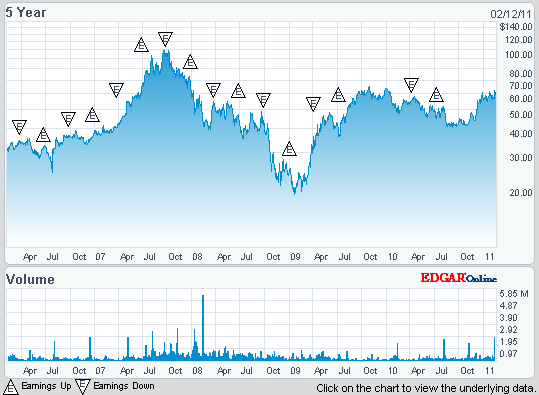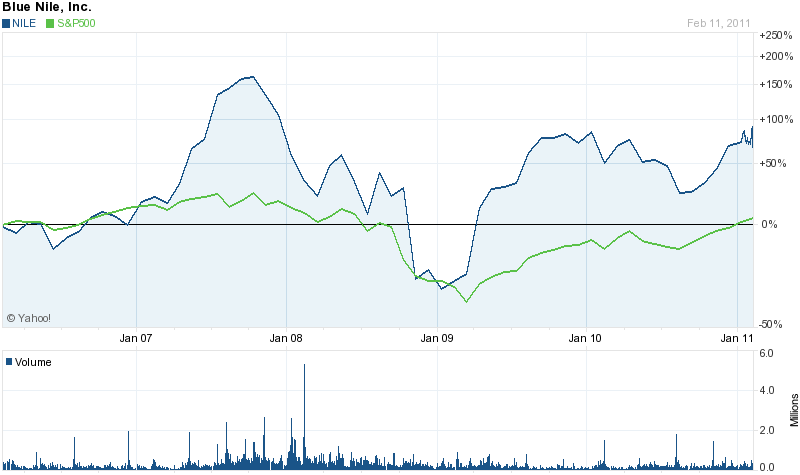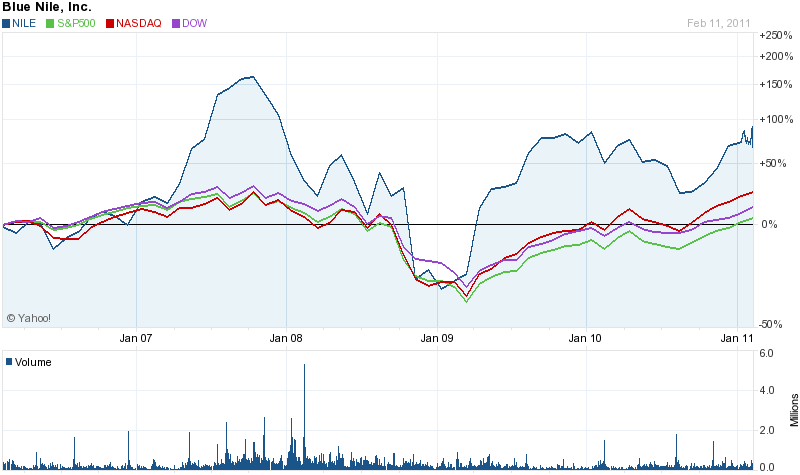Corporate Financial Analysis Assignment Answer
A Corporate Financial Analysis of Blue Nile
1. Summary
- Blue Nile is a comparatively new company which started its business in 1999 with an efficient online cost structure and a unique supply solution that eliminates traditional layers of wholesalers and brokers, thus avoiding markups by intermediaries.
- Diamonds represent the most significant component of the Company's product offerings. It offers diamonds with specified characteristics in the areas of shape, cut, color, and clarity and carat weight. A significant portion of the Company's revenues is derived from the sale of diamonds.
 The company has been awarded the Bizrate.com Circle of Excellence Platinum Award, which recognizes the best in online customer service as ranked by actual consumers.
The company has been awarded the Bizrate.com Circle of Excellence Platinum Award, which recognizes the best in online customer service as ranked by actual consumers.- Blue Nile's strategy to attract customers had two core elements. The first was offering high-quality diamonds and fine jewelry at competitively attractive prices. The second entailed providing jewelry shoppers with a host of useful information and trusted guidance throughout their purchasing process.
- The stock price of the company has been volatile historically, and may continue to be volatile. Also the sale of the common stock by significant stockholders may cause the price of the common stock to decrease.
- The risk faced by the company is from purchasers of diamonds and fine jewelry who may not choose to shop online.
- The whole industry suffered a setback from the global economic crisis of 2008 due to significant impact on consumer spending, but due to its low cost business model the company could operate profitably throughout the difficult consumer environment.
- The demand of the company is affected by seasonal variations.
- The company has not paid any dividends in the past and does not expect to pay in the near future also.
- Not only the short term debt levels as well as the long term debt levels of the company are also very less, the company's paid off all its long term debt of 0.94 million in 2009. Thus the company does not expect to borrow in the near future. The free cash flows to net income were also 2.87 in 2009-10.
- The current valuation of the company shows a price/earnings ratio of 63.3 which is much more than the industry average of 26.0. Similarly the price/cash flows of the company 32.4, also shows an increase from that of industry average of 13.0.
11. Stockholder analysis
Founded in 1999, Blue Nile has grown to become the largest online retailer of certified diamonds and fine jewelry. Internet Retailer Magazine reports Blue Nile is bigger than the next three largest online jewelers combined. The current ownership of Equity Owners is between Institutions and Mutual funds with $1158.70 Mil in institutions and $691.80 Mil in mutual funds. The three major shareholders institutions are Marathon Asset Management Llp, Morgan Stanley investment Management Inc. and Fidelity Management and Research Company owning nearly 38% of the amount held while Baron Growth retail and American Funds NVIT Growth II owns 14% of the total shares held. (Morning Star.com, Feb 2011). The concentrated Institutions shareholders are Lane Five Capital Management, Lp 54% and Baron focused Growth Retail as Funds concentrated shareholders (35%).
The management of Blue Nile consists of Ms. Diane Irvine who is the chief executive officer, president and director of the company since May 2001. Mr. Mark Vadon is the executive chairman and chairman on board, Mr. Vijay Talwar is the Interim Chief Financial Officer and Susan Bell is the senior vice president.
The Board, upon the recommendation of the Company's Nominating and Corporate Governance Committee, is responsible for selecting members to fill Board vacancies and nominating candidates for election by the stockholders at the annual meeting of stockholders. The important point about corporate governance at Blue Nile Inc. is that there is no fixed term limits and mandatory retirements ages for directors at the company.
111. Risk and Return.
The performance of the company in terms of price history for the last 5 days showing daily open, high, low and close of the stock is shown below:
| Date | Open | High | Low | Close | Volume |
| 02/11/2011 | 55.81 | 57.83 | 54.09 | 55.87 | 1.99 Mil |
| 02/10/2011 | 59.94 | 64.45 | 58.94 | 63.66 | 1.26 Mil |
| 02/09/2011 | 61.08 | 61.08 | 59.44 | 60.38 | 0.37 Mil |
| 02/08/2011 | 62.85 | 62.85 | 60.87 | 61.16 | 0.28 Mil |
| 02/07/2011 | 61.12 | 63.72 | 61.12 | 62.87 | 0.23 Mil |
Retrieved from: Morning Star.com
A table showing the quarterly comparison of Total returns of Nile with Specialty retail and S&P 500 is shown below:
| Total Return % (12/31/2010) | 1-Month | 3-Month | 6-Month | YTD | 1-Year | 3-Year | 5-Year | 10-Year | 15-Year |
| NILE | 15.39 | 28.25 | 21.20 | -9.90 | -9.90 | -5.71 | 7.20 | -- | -- |
| Specialty Retail | 0.55 | 6.00 | 32.38 | 21.84 | 21.84 | 5.43 | 3.09 | 11.96 | 11.89 |
| S&P 500 TR | 6.68 | 10.76 | 23.27 | 15.06 | 15.06 | -2.86 | 2.29 | 1.41 | 6.76 |
| +/- Specialty Retail | 14.84 | 22.25 | -11.18 | -31.74 | -31.74 | -11.14 | 4.11 | -- | -- |
| +/- S&P 500 TR | 8.71 | 17.50 | -2.07 | -24.96 | -24.96 | -2.85 | 4.91 | -- | -- |
A Chart indicating the earnings of the company for the last five years is shown below, when Nile is compared with S&P 500 Index the Adj. beta is 1.40 and the Jensen’s Alpha is .631% and the correlation coefficient is 0.653. This indicates that the correlation between the stock and the S&P index is of .653 which means that Nile’s performance is not exactly like that of the market index but it is nearly the same upto 65%. A beta of 1.4 also shows that the stock is more volatile than the index whereas Alpha is a measure of residual risk (sometimes called "selecting risk") of an investment relative to some market index. Thus with the help of Alpha and beta the return of the stock = Alpha + beta*index return. A chart showing the comparison of Nile with S&P index and a comparative chart showing Nile with S&P index, Nasdaq and Dow are shown below. The best fit line using least square process with stock returns in the y axis and index returns on the x axis shows that returns of Nile when compared with S&P 500 on 5 years basis shows a higher return of 7.92%

| Total Return % (02/11/2011) | 1-Day | 1-Week | 1-Month | 3-Month | YTD | 1-Year | 3-Year | 5-Year | 10-Year | |
| NILE | -12.24 | -8.50 | -1.79 | 15.24 | -2.09 | 6.30 | 0.40 | 11.04 | -- | |
| Specialty Retail | 0.91 | 4.10 | 5.78 | 7.75 | 6.67 | 36.81 | 11.72 | 4.50 | 11.10 | |
| S&P 500 TR | 0.56 | 1.46 | 4.44 | 10.06 | 5.90 | 25.72 | 2.04 | 3.12 | 2.03 | |
+/- Specialty Retail | -13.15 | -12.60 | -7.57 | 7.50 | -8.76 | -30.51 | -11.31 | 6.53 | -- | |
| +/- S&P 500 TR | -12.80 | -9.96 | -6.24 | 5.19 | -7.99 | -19.42 | -1.63 | 7.92 | -- |



The weekly risk profile of Nile:
Jensen’s Alpha: .631
R2 correlations: 0.426
The expected return on stock= Rf+b(rm-rf)= 2.5+ 1.4(4.14-2.5)= 4.796 or 4.8%
The key ratios of the company are shown below:
| Price & Volume | ||||
| Recent Price $ | 55.87 | |||
| 52 Week High $ | 64.45 | |||
| 52 Week Low $ | 40.70 | |||
| Average Vol (Mil) (RTMA) | 0.29 | |||
| Beta | 1.51 | |||
| Share Related Items | |
| Market Cap. (Mil) $ | 803.76 |
| Shares Out (Mil) | 14.39 |
| Float (Mil) | 6.94 |
| Dividend Information | |
| Yield % | 0.00 |
| Annual Dividend | 0.00 |
| Payout Ratio (TTM) % | 0.00 |
| Financial Strength | |
| Quick Ratio (MRQ) | 1.10 |
| Current Ratio (MRQ) | 1.30 |
| LT Debt/Equity (MRQ) | 2.00 |
| Total Debt/Equity (MRQ) | 2.00 |
| Valuation Ratios | |
| Price/Earnings (TTM) | 59.40 |
| Price/Sales (TTM) | 2.41 |
| Price/Book (MRQ) | 19.00 |
| Price/Cash Flow (TTM) | 48.90 |
| Per Share Data | |
| Earnings (TTM) $ | 0.94 |
| Sales (TTM) $ | 23.14 |
| Book Value (MRQ) $ | 3.41 |
| Cash Flow (TTM) $ | 1.14 |
| Cash (MRQ) $ | 7.87 |
| Mgmt Effectiveness | |
| Return on Equity (TTM) | 36.60 |
| Return on Assets (TTM) | 15.80 |
| Return on Investment (TTM) | 35.90 |
| Profitability | |
| Gross Margin (TTM) % | 22.40 |
| EBIT Margin (TTM) % | 6.40 |
| Profit Margin (TTM) % | 4.20 |
Investments
The company has not made any investments in the recent past.
Dividends
The company has not paid any cash dividends on its common stock since inception, and it is not anticipated that cash dividends will be paid on shares on the common stock in the foreseeable future.
References
- http://www.annualreports.com/HostedData/AnnualReports/PDFArchive/nile2009.pdf
- http://finance.yahoo.com/q/ks?s=NILE+Key+Statistics


